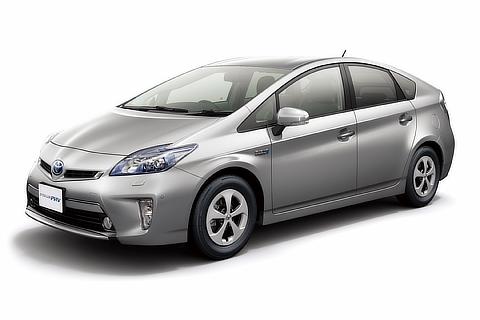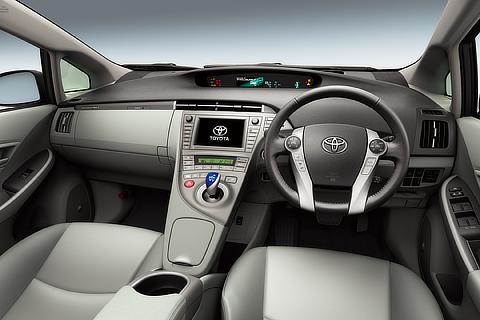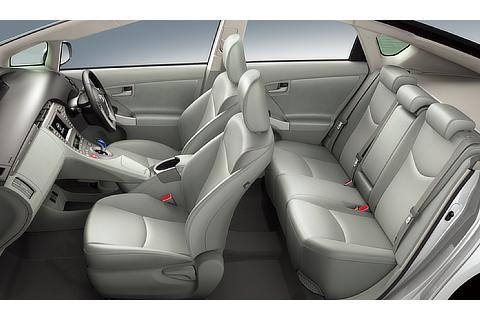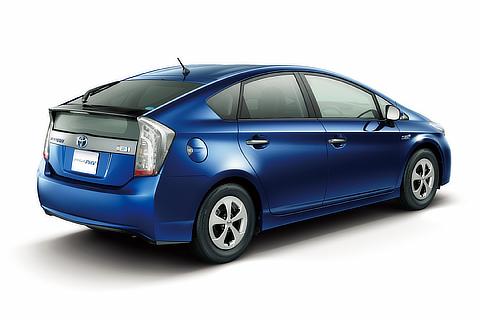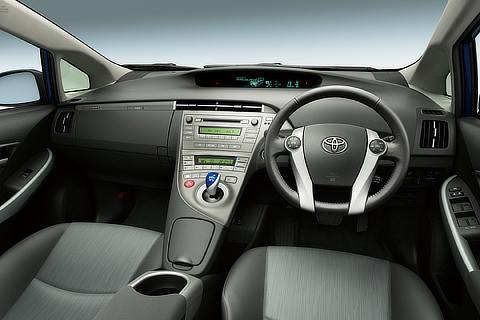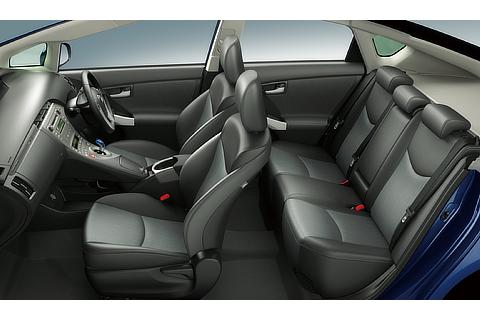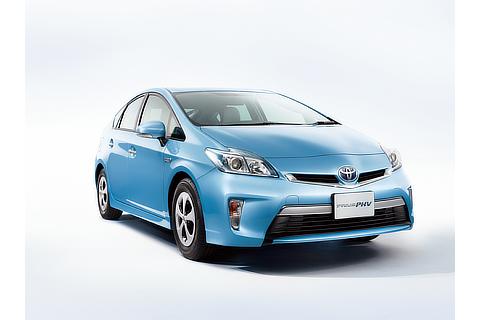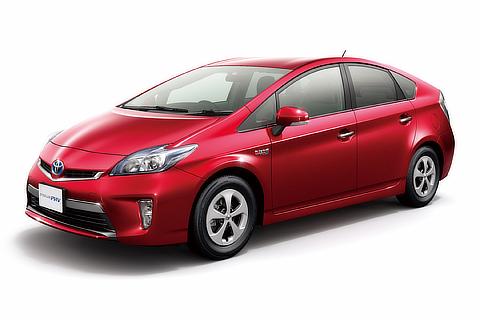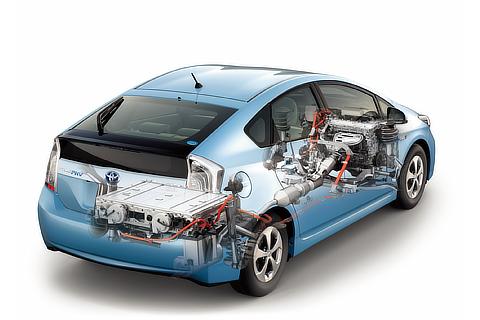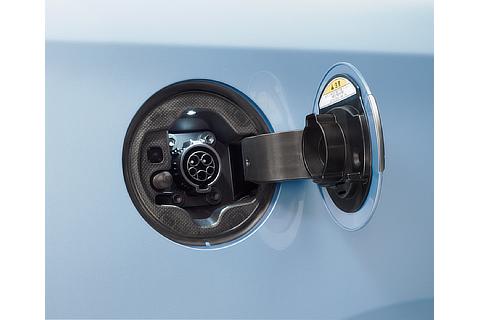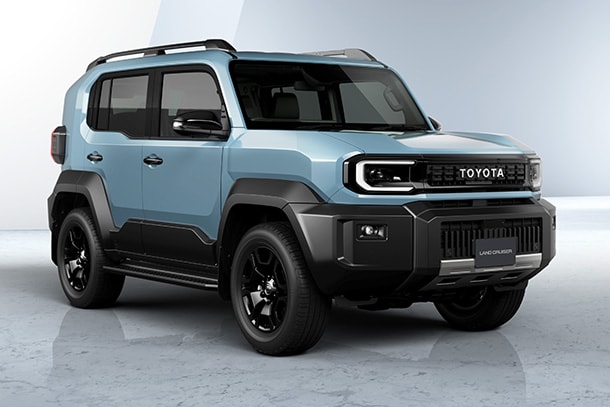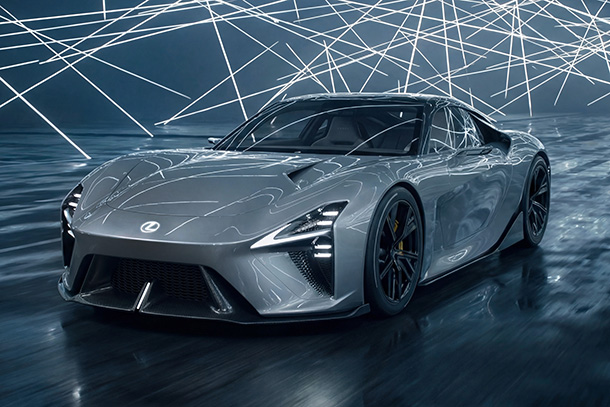Nov. 29, 2011
TMC Starts Taking Orders for Soon-to-be-launched 'Prius PHV' Plug-in Hybrid in JapanVehicle Has EV Mode Range of 26.4 km1 on Fully Charged Battery
Toyota City, Japan, November 29, 2011―Toyota Motor Corporation (TMC) began taking orders today through Toyota dealers around the country for the "Prius PHV" (plug-in hybrid), a gasoline-electric hybrid vehicle that can be charged using a household electric outlet. TMC will launch the vehicle in Japan on January 30, 2012.
-

- Prius PHV S
For short-distance trips, the vehicle operates in EV mode1, and for medium and long-distance trips, the vehicle operates in HV mode. Because the Prius PHV automatically switches to HV mode when the battery depletes to a certain level, drivers do not need to worry about remaining battery power. TMC positions this vehicle, at a price obtainable by many, as a means to promote electric vehicles suitable for widespread use.
With the goal of accelerating the wide use of electric vehicles, TMC's development of the new Prius PHV focused on three areas: 1) Overwhelmingly high environmental performance, 2) product value and ease of use and 3) affordability. With its communications link, the Prius PHV goes beyond the realm of conventional cars and demonstrates the possibility of moving into a new mobility society.
With its new high-capacity lithium-ion battery fully charged, the Prius PHV's EV mode range is 26.4 km1. The vehicle's electric power consumption rate allows it to achieve 8.74 km/kWh1.
To help provide more enjoyable and eco-conscious use of the Prius PHV, the vehicle comes standard with a new service called PHV Drive Support2, which is centered on a function that connects the vehicle and owner via the Internet. Five types of services are packaged and provided free of charge to Prius PHV owners for three years. These include a service that enables remote checking through smartphones of remaining battery power and charging station locations, and allows free use of chargers (G-Station) installed at Toyota dealers and other locations.
Overcoming oil dependence is crucial to achieving a low-carbon society, and electricity is an effective means for promoting the use of alternative energy sources. Because plug-in hybrid vehicles help reduce fossil fuel consumption and CO2 emissions3 by using electricity, TMC positions them as the pillar of next-generation environmental vehicles after HVs. TMC aims for widespread use of next generation environment-friendly vehicles by bringing the Prius PHV to market.
Sales channels in Japan
All Toyota, Toyopet, Toyota Corolla and Netz dealers
Sales target for Japan
35,000 to 40,000 units per year
Assembly Plant
Tsutsumi Plant, Toyota Motor Corporation
Manufacturer's Suggested Retail Prices
| Grade | Hybrid system | Driveline | Price* | |
|---|---|---|---|---|
| S | THS II Plug-in with reduction gear | Front-wheel drive | 3,200,000 yen | |
| G | 3,400,000 yen | |||
| Leather package | 4,200,000 yen | |||
| *Includes consumption tax, but excludes recycling fees. Prices differ in Hokkaido and Okinawa | ||||
Vehicle Outline
High Environmental Performance only Possible with a PHV
The Prius PHV features the Toyota Hybrid System II (1.8-liter gasoline engine, electric motor and reduction gear) coupled with a high capacity, new 4.4 kWh lithium-ion battery to significantly improve EV driving performance (cruising range, power and maximum speed). Furthermore, high-efficiency energy recovery has been achieved through an increase in the amount of regenerated electricity, resulting in longer EV range and better fuel efficiency. The vehicle is also equipped with a high-efficiency on-board charger capable of charging to full in approximately 90 minutes at AC 200 V (180 minutes at AC 100 V).
Improvements in system efficiency, a reduction in body weight, and the adoption of low rolling-resistance tires have resulted in an electric power consumption rate that allows the vehicle to achieve 8.74 km/kWh1. When fully charged, the Prius PHV's EV mode range is 3 km longer1, (approximately 13% better) than the 23.4 km1 achieved by its forebear.
The HV mode fuel efficiency, after the battery has been depleted, still maintains an efficiency of 31.6 km/L1.
Reduced Environmental Impact with TMC's Proprietary Eco-Vehicle Assessment System (Eco-VAS)
Environmental goals were established at the start of the development phase so that environmental impact could be reduced in a well-balanced way.
Life Cycle Assessment (LCA) was carried out to reduce the total amount of CO2 emissions and other air pollutants, not just in the driving phase, but also throughout the entire life cycle of the vehicle from production to disposal (approximately 43% lower compared to gasoline-powered vehicles of the same class, approximately 9%3 lower compared to the base Prius). When using electricity generated from renewable energy such as solar or wind power, CO2 emissions can be further reduced.
Plug-in Hybrid System Specifications
Engine
Type
2ZR-FXE
Displacement
1,797 cc
Maximum output
73 kW (99 PS)/5,200 rpm
Maximum torque
142 N-m (14.5 kgf-m)/4,000 rpm
Motor
Maximum output
60 kW (82 PS)
Maximum torque
207 N-m (21.1 kgf-m)
System maximum output*
100 kW (136 PS)
Battery type / capacity
Lithium-ion, 4.4 kWh
*Total system output produced by the engine and the battery (based on TMC calculations)
| Engine | Type | 2ZR-FXE |
|---|---|---|
| Displacement | 1,797 cc | |
| Maximum output | 73 kW (99 PS)/5,200 rpm | |
| Maximum torque | 142 N-m (14.5 kgf-m)/4,000 rpm | |
| Motor | Maximum output | 60 kW (82 PS) |
| Maximum torque | 207 N-m (21.1 kgf-m) | |
| System maximum output* | 100 kW (136 PS) | |
| Battery type / capacity | Lithium-ion, 4.4 kWh | |
| *Total system output produced by the engine and the battery (based on TMC calculations) | ||
Nimble EV Drive and a Variety of Driving Modes
The power generated by the new high-capacity lithium-ion battery enables a highly responsive and nimble drive that shows no effect of the approximately 50 kg weight increase from the base Prius.
The EV mode1 produces smooth and responsive acceleration, which can be maintained up to 100 km/h. When battery power depletes beyond a certain level, the vehicle smoothly transitions to HV mode.
Sound-absorbing and soundproofing materials for reducing road and engine noise have been optimally positioned, and measures have also been implemented to reduce wind noise, achieving superbly quiet operation.
In addition to the standard drive mode, the driver is able to select a number of other modes including Eco Drive Mode, Power Mode. This, in addition to the EV1 and HV modes, gives the driver the freedom to choose the most appropriate driving style for any given situation.
Full Assortment of Features Befitting a Next-generation Vehicle
The Prius PHV comes with the following list of features while retaining the aerodynamic performance and basic equipment of the base Prius:
Charging Equipment
- Standard compact, lightweight charging cable (5 m, AC 200 V4) facilitates easy charging
- Charging port employs push-open type lid for easy opening and closing; Lid also features charging status indicator and LED light to enable ease of charging in darkened spaces
- A control unit on the charging cable supports safe charging operation by monitoring for electrical leakage
- Vehicle comes equipped with timer that helps set charging time to best suit use schedule or use less-expensive nighttime electricity rates
Cabin Amenities
- Standard front heated seats that warm the shoulders and back quickly provide comfortable seat temperatures and also helps efficient cabin warming
- "My Room" function allows passengers to enjoy audio programs, air-conditioning5, heated seats and other features while the vehicle is plugged in
- Standard remote-control air-conditioning system allows control from vehicle's key when vehicle is plugged in or has certain level of battery power remaining
- High-capacity, new lithium-ion battery allows comparable trunk space to the base Prius (approximately three golf bags)
Safety Equipment
- Steering-assisted vehicle stability control (S-VSC), six supplemental restraint system (SRS) airbags, and active headrests for driver and front passenger are standard
- Optional Pre-collision Safety System (equipped with millimeter-wave radar) results in class-leading6 safety
- Advanced GOA7 collision-safety body that has been further evolved by incorporating the concept of omni-directional safety
- Pedestrian-injury-lessening body structure for further reduction of pedestrian head injuries gives class-leading level of protection
Exterior and Interior Design that Communicates the Prius PHV's Originality
- Front upper grille employs chrome-plated garnish and special blue headlights, while rear combination lights use clear lenses for tail and brake lamps, creating sophisticated, PHV-only look
- Trapezoidal lower grille, door handles, backdoor garnish and other similar parts are in silver, emphasizing the clean and premium look
- Special logo on the front-side, rear and instrument panel highlights vehicle's PHV identity
- Vehicle comes in total of eight body colors, including new True Blue Mica Metallic (8W1) and Attitude Black Mica (218), and Dark Blue Mica (8S6), unavailable for the base Prius in Japan
Service to Support Enjoyable and Eco-conscious Use
To support enjoyable and eco-conscious use of the Prius PHV, the Prius PHV comes standard with PHV Drive Support, which packages the following five services and is provided free of charge to all Prius PHV owners for three years:
- Owner's navigator8: A service used through a smartphone, tablet PC or personal computer, to support enjoyable learning of how to effectively use the vehicle.
- eConnect8: Allows the user to check, with a smartphone, vehicle status (battery power and EV range) and locations of nearby charging stations via the Toyota Smart Center (TSC). This service also provides ESPO, an eco-drive support system that displays user fuel-efficiency records and comparisons to other Prius PHVs in Japan. Additionally, a maker-optional navigation system enables remote operation through smartphones of the vehicle's air conditioner4 and charging system.
- Toyota Friend8: A proprietary social networking service that provides charging and service reminders via "tweet"-like alerts. It also enables communication amongst Prius PHV users.
- Battery care and checking: Based on battery usage information sent to the Toyota Smart Center, dealers can provide Prius PHV users with advice on how to better use the vehicle's battery.
- Charging service: Prius PHV users can use charging stations (G-Station) installed at Toyota dealers in Japan free of charge for an hour.
TMC is aware that managing household supply and demand of electricity will be important to help electric vehicles, including the Prius PHV, gain widespread use. To this end, TMC has been developing products for safe and efficient charging. Toyota Housing Corporation, a group company, will start sales of charging outlets, wall-mounted chargers and pole-type chargers for home use in January 2012. It will also launch the "H2V Manager" next January, a tool to support home-based charging that optimally controls the charging of vehicles based on the home's electricity consumption.
1Cruising range and fuel efficiency figures are based on the JC08 Japanese test cycle and verified by the Ministry of Land, Infrastructure, Transport and Tourism of Japan (MLIT). EV mode range (on fully charged battery) and average fuel consumption were calculated under specified testing conditions; these will vary greatly depending on driving conditions and driving methods. Air conditioner use, driving method, road conditions and other factors can mean that, regardless of remaining battery charge, pure EV mode will be interrupted and the engine will start.
2Requires user registration
3Average of CO2 emissions will vary depending on driving conditions and driving methods
4AC 100 V cable available for substitution or additional purchase
5Only for cooling
6Compared to vehicles of similar engine displacement
7Global Outstanding Assessment, Toyota's voluntary collision-safety goal
8User must download appropriate applications. Communication charges incurred are the responsibility of the user.
